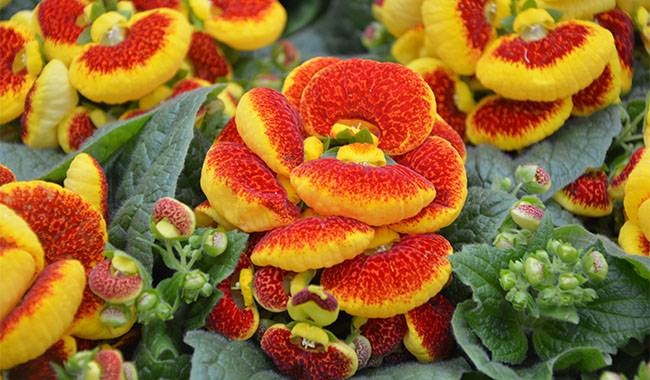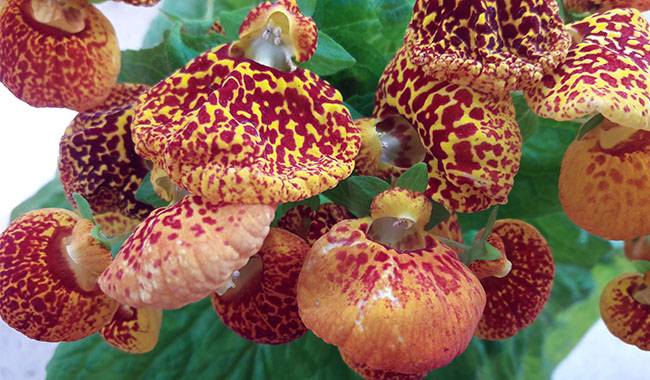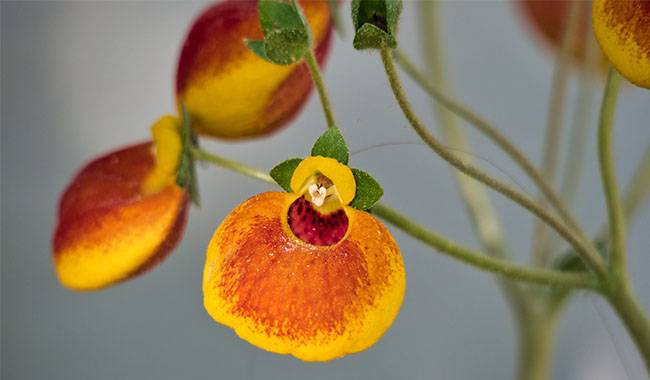
The first time I saw the spectacular flowers covered in Calceolaria’s mottled green fleshy foliage, I was mesmerized. So, when I soon found myself in a flower store, I returned home with that cherished flower. I didn’t immediately grasp the intricacies of caring for Calceolaria. It bloomed brilliantly but then became “willful”. I later learned that this plant is cultivated indoors as an annual. If you want, you can enjoy it every year. You will learn How to Enjoy The Blooming of Calceolaria Every Year in the ThumbGarden article.
WHAT KIND OF CALCEOLARIA CAN BE GROWN INDOORS?
Calceolaria (slipper flowers), or pocketbook plant has not been grown as an indoor flower for a long time. It comes from the warm tropical forests of South America. There are about 300 species in nature. These include shrub, semi-shrub, and herbaceous plant species.
Only a few miniature species have survived.
Calceolaria mexicana.
Calceolaria purpurea.
Calceolaria rugosa.
Calceolaria tenella.
Calceolaria crenatiflora (Calceolaria crenatiflora).
Calceolaria x herbeohybrida.
The most commonly cultivated as a house plant today is Calceolaria hybrida, which grows to 13-15 inches (35-40 cm) tall. The light green leaves are topped with flower stalks that bloom with oddly colored buds.
The flowers can be monochromatic if the room is too warm. The spots remain at the plant’s optimum temperature of 59-68 °F (15-20 °C). There are also streaks on the petals, very small contrasting color spots, and thin edges on the edges of the petals. The color palette varies from white to deep gold, burgundy, or soft pink.
Under natural conditions, these plants are perennials. It’s a shame, but on our windowsills, Calceolaria usually only has an abundance of life and flowers for one year. Left for the next season, they just sit quietly in their pots with a few weak inflorescences or die quietly.
This is what would have happened to my specimens if I had not been given information on how to preserve Calceolaria on the windowsill for a long time.
CARE AND GROWING CONDITIONS OF CALCEOLARIA

The plant is a capricious species that responds immediately to changes in temperature, soil composition, and irrigation schedules. What’s more, in late spring I had to work hard to keep the aphids out, and they did not want to be separated from the leaves of Calceolaria. But the aphids’ flowering period has overcome all the inconveniences and hassles associated with caring for them.
I was lucky enough to buy a bush of Calceolaria whose buds had formed and they gradually opened and looked delightful for over a month. I carefully cut off the wilted pieces with scissors.
Temperature
Buds of Calceolaria form well at temperatures up to 68 °F (20°C). If the room is warmer, the plant will likely abandon the buds it has already collected and will not flower. Warmer temperatures can also activate pests and cause the edges of the leaves to dry out.
It prefers these cool temperatures, which is the main difficulty in growing Calceolaria in a room. At the same time, it is afraid of ventilation. I had to put it in a shady cul-de-sac with the windows slightly shaded beforehand.
Humidity and watering
When it comes to humidity, ‘Southern Belle’ is reverent and happily accepts a fine spray of water from a sprayer. However, it is important to moisten the air around Calceolaria and not allow water to get on the leaves as this can lead to rot.
I quickly got tired of spraying water, so I just put a few small containers of water around the pot. Then I moved it to a pebble dish and moistened it regularly. It’s easier and less time-consuming to do this.
Water the plants regularly with well-drained soft water. Remove excess water from the tray as soon as possible to prevent root rot. calceolaria does not like the soil to dry out and should be watered as soon as the top layer becomes dry. I use a home potting compound during active growth and flowering (about once every two weeks).
Lighting
Despite its southern origins, this plant is afraid of direct sunlight and its delicate foliage can be burned. calceolaria prefers windows facing east or southeast and creating diffused light.
However, a day length of at least 12 hours is desirable, so the plant needs to be illuminated with plant lights in winter.
HOW CAN I ENJOY THE FLOWERS OF CALCEOLARIA EVERY YEAR?
Leaving Calceolaria indoors after it blooms and waiting for it to bloom again the following year is a daunting task. I tried to keep my first dark yellow Calceolaria. after flowering I simply cut off the green part and put the pot in a shady shed, out of the light. I looked in from time to time and watered it a bit.
After 3 months the plant woke up and even spat out a few buds, but the blooms were weak, the rich color disappeared and the flowers themselves were greatly worn out. I realized that such overexposure was useless, so I did not leave Calceolaria for the new season.
But I like it so much that I don’t have to buy a new bush every year, but I still appreciate its flowers. Do you know how to do it? I grow Calceolaria from seed every year. in spring, my windowsill is full of shoots anyway.

PROPAGATION OF CALCEOLARIA FROM SEEDS
My favorite seeds are those of Calceolaria Dainty Mix. It is not so capricious, the seeds have different flower colors and bloom in 7-8 months after sowing. By the way, it also flowers longer than the others, almost 2.5 months.
I sowed it at the same time as tomatoes in mid-March. In this case, calycanthus will bloom in the fall. I recently found out that you can also sow seeds in the fall and flower in the spring. I haven’t tried it myself. I suspect that in this case, you need some light at night.
I sowed the seeds in peat but did not cover them with soil, just moistened them. To avoid picking, I put one pellet at a time in a separate cup with soil. Calceolaria seeds are very small and dust-like, so they are sold with a protective cover to give the plant an initial supply of useful material and increase germination.
Cover with a glass or clear bag and regularly ventilate and moisten the seeds. The optimum temperature for germination of calycanthus seeds is 68 °F (20 °C).
Seedlings emerge in about 2 weeks, sometimes 3 weeks. At 1.5 months old, prepare a mixture of leaf and turf soil and peat with a little coarse river sand for planting in a permanent location. Calceolaria lives well in a geranium soil mixture. A drainage layer is essential, as this flower does not tolerate high humidity and standing water.
After transplanting, I treated Calceolaria with Epin to strengthen its immunity and improve its adaptation to the new location. To form a bush and remove excess green masses, I pruned once, leaving 3 pairs of leaves.
An interesting variation was to plant several bushes in a long balcony planter. The flowers were in full bloom and came in a variety of shades.
5 TIPS FOR LUSH CALCEOLARIA
I’ve been growing Calceolaria for over four years now. I plan to continue planting seeds in the spring and experiment with planting in the fall. I have learned a few rules of thumb.
- Keep the temperature no higher than 68 °F (20°C) for flowers that are growing buds.
- Drink moderate amounts of water and follow a regular schedule.
- Avoid drafts and direct sunlight.
- Treat with an aphid-proof insecticide every 2 weeks.
- Don’t save the flowers for the next year, but reseed them.
So far, I have enjoyed colorful Calceolaria every year and I sincerely hope you will too.







